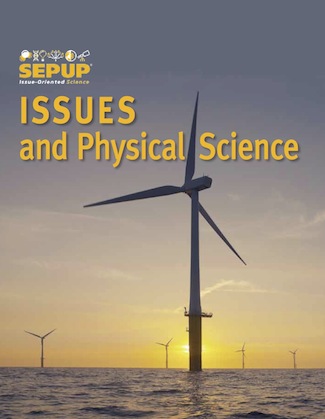IAPS: Teacher Links
Weblinks and Important Notes
Submitting data for IAPS activities: Some IAPS activities provide the opportunity for students in classrooms across the country to compare their data with each other. Click on the appropriate link to submit your students’ data.
Submit data for Activity 74, “Measuring Speed”
Submit data for Activity 82, “Braking Distance”
Shown below are several sites that relate to Issues & Physical Science (IAPS). Some provide background information to supplement the information in the student book, others provide links to supplemental information and articles you may choose to use with students.
IAPS Issues in the News
Below is a list of newspaper articles and websites that link current events to issues explored in IAPS. Use these with your students to foster discussion about current science issues.
Unit A – Studying Materials Scientifically
Professional cleaning with a green attitude
Environmentally friendly cleaning products erase grime but let environment shine
Unit B – The Chemistry of Materials
The chemistry of beauty products is going green
Unit C – Water
Bottled water versus tap: Which is safer to drink?
Unit D – Energy
Green building methods save energy, environment
Neighbors compete in Energy Smack down
US wind energy adds 1,400MW of capacity
Unit E – Force and Motion
Human crash test dummies to welcome virtual relatives
^ top
Unit A: Studying Materials Scientifically

Activity 1 Handling Hazardous Materials
Activity 3 A Plan to Separate the Mixture
Activity 4 Hazardous Materials at Home
Activity 6 Identifying Liquids
Activity 8 Measuring Volume
Activity 10 Density of Unknown Solids
Activity 11 Choosing a Cleaner
Activity 1
Handling Hazardous Materials
Video: Hazardous Materials Investigations – The Barrel Mystery
This video segment, used in Activity 1, is also on the Issues & Physical Science DVD.
Hazardous Materials Team Training
These two videos explore the training and protective gear used by the fire department in Tampa, Florida when responding to incidents involving hazardous materials. They are long, so it is best to preview and select short segments to show your students.
Hazardous Materials Team Training, part 1
Hazardous Materials Team Training, part 2
Activity 3
A Plan to Separate the Mixture
Teacher’s Guide page A-30: In Advance Preparation at the bottom of the page, change the following phrase: “To each cup containing 40 mL of 40,000 ppm iron nitrate solution add…” to instead read: “To each cup containing 40 mL of 5,000 ppm iron nitrate add …” This has been corrected in editions printed after 2012.
Teacher’s Guide page A-33: In the Teacher’s Note, please do let students separate the iron nitrate solution via evaporation. This can be done as a demonstration, but it is not suggested that students handle the iron nitrate crystals. This has been corrected in editions printed after 2012.
Activity 4
Hazardous Materials at Home
Reduce and Dispose of Household Hazardous Waste by the US Environmental Protection Agency provides strategies for reducing hazardous materials at home.
Activity 6
Identifying Liquids
Adjust the second paragraph on Teacher’s Guide page A-63 to read: “To prepare 8 cups for students and 1 cup for teacher demonstration purposes, dilute 45 mL of 40,000 ppm iron nitrate solution with 315 mL of water. Then distribute 40 mL of the resulting 5,000 ppm solution to each of the 9 cups.” This has been corrected in editions printed after 2012.
Activity 8
Measuring Volume
In the Teacher’s Guide page A-87, add this note under drawing of cube: “Note: all edges are equal in length.” This has been corrected in editions printed after 2012.
Activity 10
Density of Unknown Solids
On Teacher’s Guide page A-105 in the “Corrosive/Reactive” column in the table, change the entries to read: no, corrosive, no, no, reactive, reactive. This has been corrected in editions printed after 2012.
Activity 11
Choosing a Cleaner
The Household Products Database provides safety, health, and disposal information for household products. This database is searchable by major category or product name.
^ top
Unit B: The Chemistry of Materials
Activity 13 Product Life Cycle
Activity 14 Physical and Chemical Properties of Materials
Activity 18 Properties of Plastics
Activity 23 Producing Circuit Boards
Activity 25 Conservation of Mass
Activity 26 Incinerating the Waste
Activity 27 Reclaiming the Metal
Activity 29 The Green Computer Challenge
Activity 13
Product Life Cycle
Basic Information: Green Chemistry from The United States Environmental Protection Agency
The Green Chemistry Institute by the American Chemical Society
“Green Chemistry Takes Root” by Elizabeth Weise. USA Today, November 22, 2004.
The Great e-waste Recycling Debate
Activity 14
Physical and Chemical Properties of Materials
Teacher’s Guide page B-29: In the Materials and Advance Preparation section, note that the metals—copper, iron, and aluminum—will take time to display signs of a chemical reaction with the 1M HCl. Set up this demonstration before class so that students will observe evidence of a reaction in one class period.
On Teacher’s Guide page B-32 in the last column titled, “Reaction to HCl,” for copper, replace with “No.” This has been corrected in editions printed after 2012.
Activity 18
Properties of Plastics
The American Chemistry Council Learning Center
This site offers several resources to help teach about plastics and recycling.
Consumer Fact sheet on Copper by the U.S Environmental Protection Agency – Office of Ground Water and Drinking Water
Activity 23
Producing Circuit Boards
Teacher’s Guide page B-132: First column, between the first and second paragraphs, insert the text: “Teacher’s note: Do not soak the boards for more than 24 hours, as all of the copper will be removed.” This has been corrected in editions printed after 2012.
Activity 25
Conservation of Mass
Below is a link to download an updated version of page B-163 in the Teacher’s Guide. This has been corrected in editions printed after 2012.
Activity 26
Incinerating the Waste
Video: Waste Disposal – Computers and the Environment
This video segment, used in Activity 26, is also on the Issues & Physical Science DVD.
Activity 27
Reclaiming the Metal
Current Primary and Metal Scrap Prices can be found at
• Metalprices.com
• The London Metal Exchange
Activity 29
The Green Computer Challenge
The Federal Electronics Challenge
Recycling Waste: What You Can Do
On Teacher’s Guide page B-206 in the section Materials for each student, change “1 Student Sheet 13.1” to, “1 Student Sheet 13.2, ‘Green Chemistry Guidelines.’” This has been corrected in editions printed after 2012.
^ top
Unit C: Water
Activity 32 Mapping Death
Activity 32 & 33 Mapping Death John Snow and the Search for Evidence
Activity 36 Making Water and Alcohol Molecules
Activity 32
Mapping Death
Below are electronic versions of the transparencies that were previously only available in the kit:
Map of the 1849 Cholera Epidemic in London (without data)
Map of the 1849 Cholera Epidemic in London (with data)
Activity 32 & 33
Mapping Death
John Snow and the Search for Evidence
On the Mode of Communication of Cholera, (John Snow, 1855).
John Snow’s 1855 book “On the Mode of Communication of Cholera” is available at this site sponsored by the Department of Epidemiology in UCLA’s School of Public Health. This webpage includes the first 38 pages of the book and provides links to the complete book and to maps and more information on John Snow.
Activity 36
Making Water and Alcohol Molecules
There is no Student Sheet 36.1, “Modeling Molecules.” This has been corrected in editions printed after 2012.
^ top
Unit D: Energy
Activity 53 Home Energy Use
Activity 56 Shake the Shot
Activity 64 Electricity Generation
Activity 72 Improving Energy Efficiency
Activity 53
Home Energy Use
The Utility Connection has links to over 2,000 local utility companies.
To find power generating web pages for your area, try an Internet search for “your state or city + power or electricity,” or try the web site of your local electric utility company.
In the Teacher’s Guide section, Materials and Advance Preparation, it should read: “For the teacher, 1 overhead transparency each of Student Sheets 53.1a and 53.1b.” Student Sheet 53.1 (Anticipation Guide: Ideas About Energy) should be labeled 53.1a and the continuation of the Anticipation Guide should be labeled 53.1b (found on the reverse side of 53.1a). This correction has been made in editions printed after 2012.
Activity 56
Shake the Shot
Student Book page D-22 and Teacher’s Guide page D-29: The figure should not show a student shaking the container with the thermometer. The thermometer is likely to break if it is shaken while in the container. Remove the thermometer before shaking the shot. This correction has been made in editions printed after 2012
Procedure #7 in the Student Book: Turn the shaker on its side, remove the regular cap and gently insert the thermometer with the shaker cap attached. When the cap is secured, turn the shaker upright. This will help protect the thermometer from breaking. This correction has been made in editions printed after 2012.
Activity 64
Electricity Generation
The Energy Information Administration provides maps of the United States showing power plant locations for individual states.
Tennessee Valley Authority: Reservoirs and Power Plants
This site provides links to all of TVA’s power generating plants.
California Independent System Operator
At this site the daily forecasted available energy resources and actual demand in the state of California are show in both graph and data table format.
New York Power Authority: “Our Facilities”
Bonneville Power Administration
This site provides archived historical films about power in the Northwest.
Build a hydropower station using this paper model
Foundation for Water and Energy: “Turning to Hydropower” Includes a “walk through” of a hydroelectric power plant plus a design to make a water powered generator.
Activity 72
Improving Energy Efficiency
New Student Sheet 72.1c
New Student Sheet 72.1d
These corrections have been made in editions printed after 2012.
^ top
Unit E: Force and Motion
Activity 73 Choosing a Safe Vehicle
Activity 79 Inertia Around a Curve
Activity 84 Decelerating Safely
Activity 88 Safety For All
Activity 73
Choosing a Safe Vehicle
Teaching Suggestions: The title of the table, “Sample Response to Student Sheet 83, ‘Comparing Vehicle Features,’” should read 73.1 and not 83. This correction has been made in editions printed after 2012.
Activity 79
Inertia Around a Curve
Student Book page E-27, after completing Procedure #7: Repeat Step 7 several times until the members of your group agree on the most common path of the marble. This correction has been made in editions printed after 2012.
Activity 84
Decelerating Safely
New Student Sheet 84.2
This correction has been made in editions printed after 2012.
Activity 88
Safety For All
Teacher’s Guide: Throughout the Teaching Suggestions and Suggested Answers to Questions, replace “bumper” with “frame.” This correction has been made in editions printed after 2012.
^ top
Unit F: Waves
Activity 89 It’s a Noisy World
Activity 92 Noise-Induced Hearing Loss
Activity 94 Comparing Colors
Activity 98 Blocking Out Ultraviolet
Activity 99 Personal Protection Plan
Activity 89
It’s a Noisy World
Dangerous Decibels: Virtual Exhibit This website, from the Oregon Health and Science University, features a number of interactive simulations on various aspects of sound.
Activity 92
Noise-Induced Hearing Loss
Noise-Induced Hearing Loss This website, from the National Institute on Deafness and Other Communication Disorders, explains the cause of noise-induced hearing loss.
Activity 94
Comparing Colors
Student Support Sheet This supplemental worksheet can be used to support students with Activity 94.
Activity 98
Blocking Out Ultraviolet
EPA: UV Index Want to know what the UV index is for your community? Find out from this website from the U.S. Environmental Protection Agency.
Activity 99
Personal Protection Plan
Current UV Index Forecast Want to know the UV forecast for your region? This website from NOAA is here to help.
^ top

